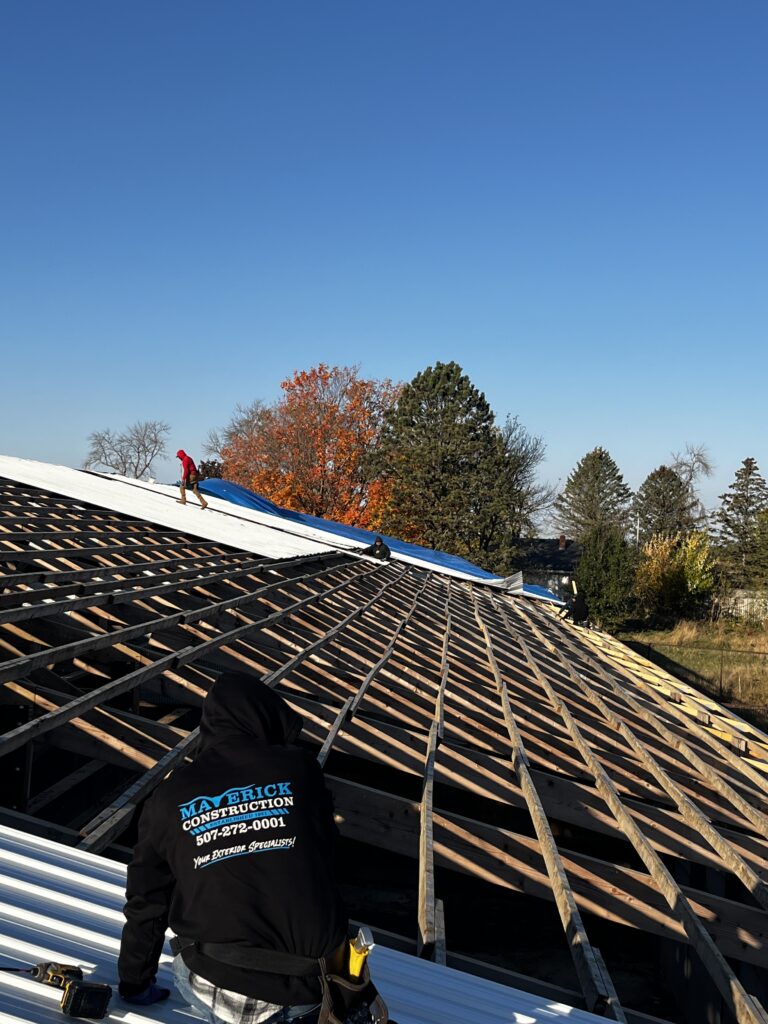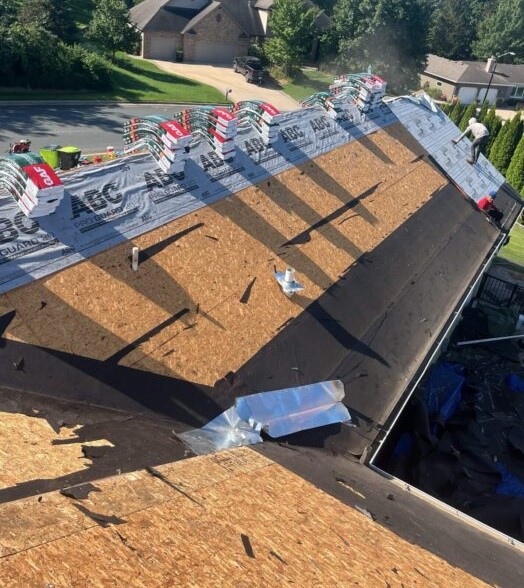Few parts of your home are as important as the roof when it comes to shelter. That part of your home that’s out of sight and out of mind, until a leak appears or a shingle goes missing, is your first defense against weather, pests and the wear and tear of time.
Knowing all about the products, alternative maintenance options, and new technologies in residence roofing are not only going to improve the performance of your roof for years to come, but can also play a huge role in increasing your home’s value and energy savings.
In this comprehensive guide, we’ll cover the basics of residential roofing, from selecting the right materials to taking care of your roof year-round.
1. Why Roof Matters
Your roof is more than a cover for your house; it is the protector of your entire investment. If a roof fails, you could end up with leaks causing water damage and mold, insulation failure, and costly repairs inside and out. In stormy, snowy or very hot regions, the right material and installation also can be the difference between a roof that lasts and one that needs constant repair. What’s more, a properly installed roof increases curb appeal and resale value. It’s a feature that potential buyers see right away and that home inspectors look at closely.

2. Popular Residential Roofing Materials
a. Asphalt Shingles
One the most common type of shingle in North America, and are durable, affordable and come in a variety of color options. They’re easy to install and can last 20–30 years, depending on quality and care.
Pros: Cheap, easy to find, lasts a decent amount of time.
Cons: May crack in harsh climates, not eco-friendly
b. Metal Roofing
Metal roofs, whether made of aluminum, steel, copper or zinc – is becoming increasingly popular because it is durable and energy efficient. They deflect solar heat, which makes it easier to lower energy costs when cooling homes during hot months.
Pros: Durable (40 to 70 years), low maintenance, and can be recycled.
Cons: More expensive initial cost, potential for loudness in rain/hail.
c. Clay and Concrete Tiles
Those are perfect for hot weather. Clay tiles are also very popular in Southwestern, Italian, and Spanish-style homes. They’re fire-resistant and highly durable.
Pros: Beauty, Durability, House-fire Shielding
Cons: Too heavy, pricey, fragile (may break when under force/impact)
d. Wood Shingles and Shakes
There is wood roofing which provides you a traditional and natural style. Shakes are hand-split and rougher; shingles are machine-cut and uniform.
Pros: Aesthetic beauty, natural insulation
Cons: Needs occasional maintenance and treatment to prevent fire or rot
e. Slate Roofing
Slate is a lavish material that is highly durable and simply looks phenomenal.
Pros: May last 100 years or more, fire- and mold-resistant
Cons: Extremely costly, heavy, hard to get installed
3. How to Choose the Right Roofing Material
Selecting the right type of roofing material, you’ll need these tips to choose a roofing material:
- Climate: Some different materials are better suited for some climates. Metal or clay roofs are awesome in hot climates asphalt shingles are great in more temperate ones.
- Cost: Consider installation, long-term maintenance and lifespan.
- Aesthetic: Your roof should complement the architectural design of your home.
- Durability: Roofing that lasts longer — even if more expensive initially — can save money over the long run.
- HOA/Local Codes: There are certain code and/or roof style requirements in some neighborhoods.
4. Roofing Installation: What to Expect
A new roof installation is a large undertaking and entails a number of important steps:
- Inspection and Estimates: A roofer will examine your old roof and offer a quote.
- Old Roofing Removal: The old roof may need to be totally removed to even get to the decking.
- Deck Repairs: If there is any parts that are damaged then they will be cut off and new pieces put on.
- Applying Underlayment: A waterproof layer is put down to protect against leaking.
- Shingle or Tile Installation: Roof prep is followed by the installation of roof shingles or tiles whichever material is called for based on the roof manufacture.
- Cleanup and Final Inspection: Debris is removed and the new roof is examined for quality assurance.
Pick local contractor who is licensed and insured. Always read reviews and ask for recommendations.

5. Essential Roof Maintenance Tips
Proactive maintenance is crucial to extend the lifespan of your roof. Here are key practices:
a. Regular Inspections
Perform visual inspection of roof at least twice a year (spring and fall), and after any major storms. Look for:
- Missing, curling, or broken shingles
- Rusted flashing
- Sagging areas
- Moss or algae growth
- Cracked caulking or sealants
b. Clean Gutters
Clogged gutters can result in water pooling on your roof and next to your foundation. You will be happy you did after each season and getting the snow and ice out of them for good.
c. Trim Overhanging Branches
Dropping limbs can damage your roof and overhanging limbs drop leaves that hold onto moisture. Pruning trees helps limit this risk.
d. Remove Moss and Algae
Zinc or copper strips can be placed at the peak of the roof or cleaners are available to kill moss and algae. Pressure-washing damages shingles, so power-wash not at all.
e. Repair Damage Promptly
Don’t put off attending to minor problems — little issues can rapidly metastasize into big leaks or structural problems.
6. Signs You May Need a Roof Replacement
Sometimes, repairs just aren’t enough. Watch for these signs:
- Shingles are missing or severely damaged across large areas
- You see daylight through roof boards in the attic
- Your roof is over 20 years old (for asphalt shingles)
- Recurring leaks or sagging areas
- Granules from shingles are collecting in your gutters
You can make a pretty penny flipping houses, if you’re good at it — and if you have the know-how and time to invest in the kind of house that’s going to pay you a pretty penny. A new roof is not a flashy, no-holds-barred investment, but it’s a good one, preventing further damage and making the home safer, which increases resale value.
7. Modern Roofing Innovations
These days, roofing choices are more than just practical. Some of the latest trends and technologies include:
- Cool Roofing
These roofs reflect more sunlight and absorb less heat, which generally translates into cooler indoors and lower air conditioning bills.
- Solar Shingles
Solar Roofs like the Tesla Solar Roof offer power and protection all in one.
- Green Roofs
Green roofs — which are partially or entirely covered in vegetation, helping with insulation, runoff, and air quality — are commonly used in urban settings.
- Synthetic Roofing Materials
Recycled rubber and plastic composites offer the look of slate or wood but are lighter and need less maintenance.
8. Roofing and Home Insurance
Your roof plays a big role in your homeowner’s insurance. A well-maintained, newer roof can lower your premiums, while an old, damaged roof might raise them—or even disqualify you from coverage. Be sure to:
- Photograph your roof after installation or repairs with “before” images.
- Keep receipts and warranties.
- Make regular inspections and document any storm damage.
9. Final Thoughts: Invest in Your Roof, Invest in Your Home
Your roof is more than a shelter — it’s an investment in your home’s safety, efficiency and value that will last for a generation or more. The right material, being properly installed and vigilance with maintenance can save headaches and expensive repairs down the road.
Whether you’re building a new home or making some much needed updates to an older one, when it comes to roofing, don’t skimp on your decisions. Talk to professionals, shop around, and always, always, put quality first. Your roof protects everything underneath it — don’t let it fall down on the job.
